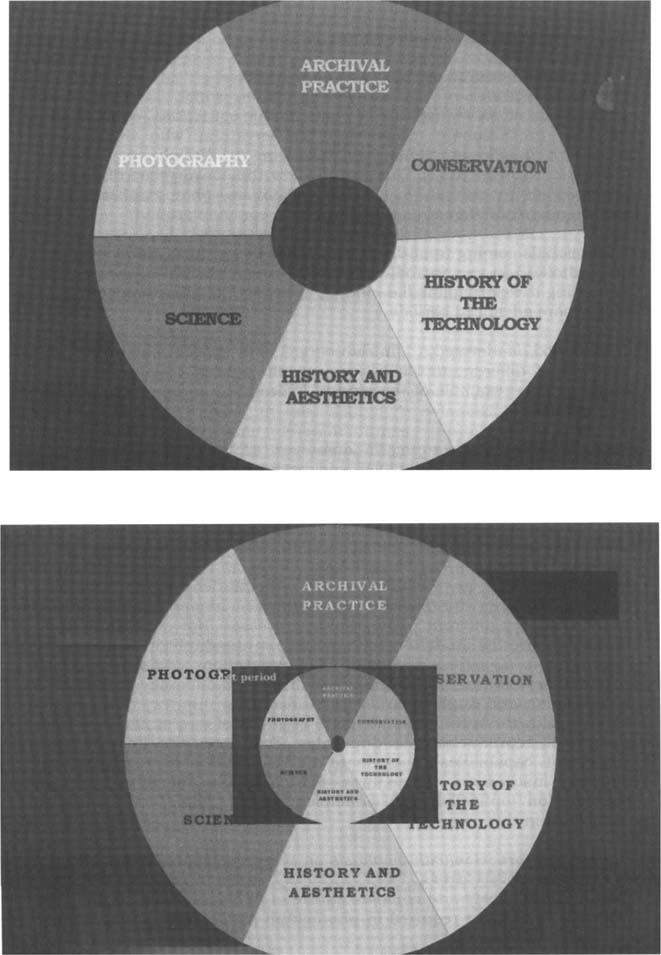
Topics in Photographic Preservation 1999, Volume 8, Article 7 (pp. 44-55)
The aim of this project is to create a training program, based on current ideas and past experiences in the field of photograph conservation, to be applied in the education of Mexican conservators. It has the main intention, though, of arriving to an educational model that could be used by conservation educators in other countries. Basic concepts and criteria derived from the work of pioneers, educators and actual practitioners in the United States have served as guidelines in the organization of this model. This proposal is also an attempt to promote specialization and the standardization, through an academic homogenization, of the profession in different countries. Following current efforts by American educators1, it is intended to reinforce the idea of certification, interdisciplinary collaboration, and further specialization of photograph conservators.
Although the ultimate goal of a training program lays in its application in the education of future photo-conservators, this proposal might contribute to the definition of the field by presenting a profile and a set of knowledge to start a career in photographic conservation. It has also the objective of summarizing current ideas about photograph conservation practice and principles in a single proposal.
A reflection on the kind of knowledge and skills required to specialize and fulfill the needs of photographic collections, was necessarily the first step in the design of this program. Not only do past achievements and present situation of photographic collections were considered in this exercise, but also the “ideal” or optimum curricula for photograph conservators.
The first task in designing a program is the definition of the outcome; that is, the various skills, attitudes and knowledge that students are supposed to acquire and demonstrate after completing the program. For the purpose of this training program the following definition of a photograph conservator was taken into consideration:
The academic level of graduate students in Art Conservation would be the starting point of this training program. Knowledge provided by existing programs in art conservation, such as materials science, analysis techniques, art history, paper, objects and painting conservation, etc., has been the platform for the design of this program.
Students coming from the five-year program in Conservation of Cultural Heritage, offered at the Escuela Nacional de Conservación, Restauración y Museografia, INAH (Mexico City), would be the candidates, in that country, for the training program in photograph conservation. Up to now the existing curricula has only included photograph preservation as an elective course at the end of the program (during the last semester). Specialization or advanced level courses are not offered in this institution or in any other institution in the country.
Apprentices or non school-trained conservators would be freely admitted in the first -introductory- period and, if fulfill the prerequisites, in the more advance periods (2nd, 3rd, 4th semesters)
In order to organize the necessary skills and knowledge into series of courses, different areas of study, within and outside the actual field of conservation, were determined. Based on current training programs and opinions by American educators in photograph conservation2 six areas of study were defined:
The six areas are repeated, with different content each time, through the four semesters proposed for the training program.
The content of each area was determined by the type of knowledge required to understand, preserve, reproduce, intervene, investigate, and protect, the wide variety of photographic processes that can be found in photographic collections. It became apparent in this exercise that photographic materials are grouped in a single specialty by concept (our understanding of what they are and represent) and not so by the kind of materials they are made of; since they can be made of virtually anything. It also became apparent that photographic processes define most conservation strategies and therefore should constitute the medullae of each area. Organizing the content of courses by grouping photographic processes that share technical and chronological aspects has proven successful in current training programs and short seminars. Within each photographic process, though, information should be delivered in the traditional sequence: nature → deterioration → conservation.
As in other conservation specialties, the reproduction of historic processes and technologies has proven to be very useful in the investigation and understanding of photographic materials, their behavior and deterioration.

The first semester of the two-year program, which is centered on preservation or preventive care of photographic collections, could be also open to professionals, other than conservators, who demonstrate interest and who are willing to specialize in disciplines related to photograph conservation. This would allow the convergence of different professionals (conservators, curators, scientists, photographers, etc.,), and therefore of different points of view in a common ground.
Professionals coming from disciplines other than conservation would be only admitted in this introductory period and probably in those areas, pertaining their discipline (i.e. photography, art history, chemistry, etc.), of the more advanced periods.
This period is devoted to introductions and would only provide an overview of different topics concerning photograph conservation. The following is an example of the kind of information to be covered during the first period:
The course in Photography is organized around presentations and demonstrations of the principles and basic notions behind the correct reproduction and duplication of historic images. It will therefore promote the use of densitometric methods in arriving at optimal exposure and development conditions for different films. Processing for permanence should be practiced during this period.
It is not intended, at this point, to teach the students all the technical details involved in the reproduction of different kinds of prints, that is prints made by different photographic processes. Nor does this course pretend to give the student a solid practice in the duplication of historic negatives. It is rather a theoretical presentation, complemented by practical demonstrations, of the possibilities and difficulties involved in reproduction and duplication work. Students, in this way, will become familiar with the technical and visual qualities of successful (and non-successful) reproductions or duplicates. They may also improve their judgement capabilities to evaluate work done by photographers at different institutions. Procedures for correcting different types of deterioration (optically), and principles behind them, would only be mentioned in this course.
Owing to the variety and complex nature of photographic materials, the gamut of knowledge required in photograph conservation is even wider than that required in other specialties. It was therefore necessary to add some courses that are not normally included in art conservation programs. To the traditional triptych of conservation -practice, art or cultural history and science-3 photography and archival practice were added as distinct areas.
Even though photograph conservation should be defined within the context of Art Conservation in terms of training, ethics and practice, further studies in these two areas are required to provide complete education. The lack of the experience and management skills, which can only be obtained through an every-day-work in photographic archives, has been pointed out as a drawback of art conservation programs.4 By adding courses on photographic reproduction and archival practice it is hoped to fulfill the need of cultural and archival institutions.
Few problems arise when topics that should be included in a training program are organized into different areas and distributed along school periods. Not only do time periods need to be reasonable for the amount of information delivered, but they should be balanced in terms of the work required for the different areas (Science, Conservation, Photography, History of the Technology, History and Aesthetics, Archival Practice). The amount of time invested in one area should not be much greater than the required for other areas.
Every area should keep an internal logic within the same period and through the whole program; logic that guarantees the thematic continuity from one period to the next. However, topics introduced during each period should be covered to completion within that period.
Apart from the first period, which would provide an overview of different topics concerning photographic conservation, advanced periods have been structured as conclusive units containing different aspects of the history, technology, deterioration and conservation of photographic materials. Each period contains certain topics, which together form a basic set of knowledge on certain photographic processes (their introduction and development through history, forms of decay, and methods for conservation and preservation).
Offering conclusive periods, instead of linked courses covering similar subjects at different levels of complexity, would give the students the flexibility of attending the four periods at different moments of their careers. This, considering that some conservators might need to alternate their studies with other professional activities. The sequence in which periods have been presented, though, should be followed to optimize the learning process in each of them.
Even when the learning process can be virtually unlimited, students would be prepared, at the end of each period, to keep increasing their knowledge on subjects they are already familiar with.
Although periods are relatively independent, areas should be linked horizontally by a single theme (one photographic process a time). Concentrating only on certain photographic processes each semester would allow the students to elaborate closer and deeper analysis and hopefully solid proposals.
By presenting each photographic process from the different perspectives that the six areas can provide, students would also have a better understanding of it
The content of each area course, therefore, is not a list of subjects in which the order can be altered; contents have been organized in a sequence that allows their coincidence (or proximity) in the six areas. While studying the evolution of the daguerreotype process, for example, students would be learning in other areas about its chemistry, deterioration, treatment possibilities, housing, storage and display.
Although the guiding sequence (within each period and through the whole program) is a chronological line, in which photographic processes appear accompanied by complementary courses, another guiding sequence, based on the nature of photographic materials, is prevailing the first one. Apart from the first -introductory- period, the Scientific Area has been organized by grouping themes that show similarities from the chemical point of view. For example, topics selected for the second period are mainly related to image forming substances and they all pertain to inorganic chemistry. While both, the third and fourth periods, include topics pertaining to organic chemistry, the third one is focused on natural polymers employed as photographic binders; and the fourth one on polymers (modified and synthetic) that have been used as photographic supports. There are other topics, such as dye-based images and analytical techniques in conservation, in the fourth period. These, owing to their complexity were included towards the end of the program.
Photograph conservation should keep contact and learn from other specialties but should be recognized as a distinct discipline among the many fields of conservation.
This project is an effort to synthesize current trends, efforts and ideas in a single proposal for a curriculum in photograph conservation. It is not only a theoretical exercise but suppose the introduction of a training program, either in synthesized or complete version, in Mexico; and hopefully in other countries where specialists in photograph conservation are needed. The first period could be introduced without major modifications; lectures, laboratory sessions, reading and bibliography have been planed and organized.
Interdisciplinary collaboration though, between conservators, photo historians, scientists, photographers, and curators, is essential for the development of a consistent program and a field in photograph conservation.
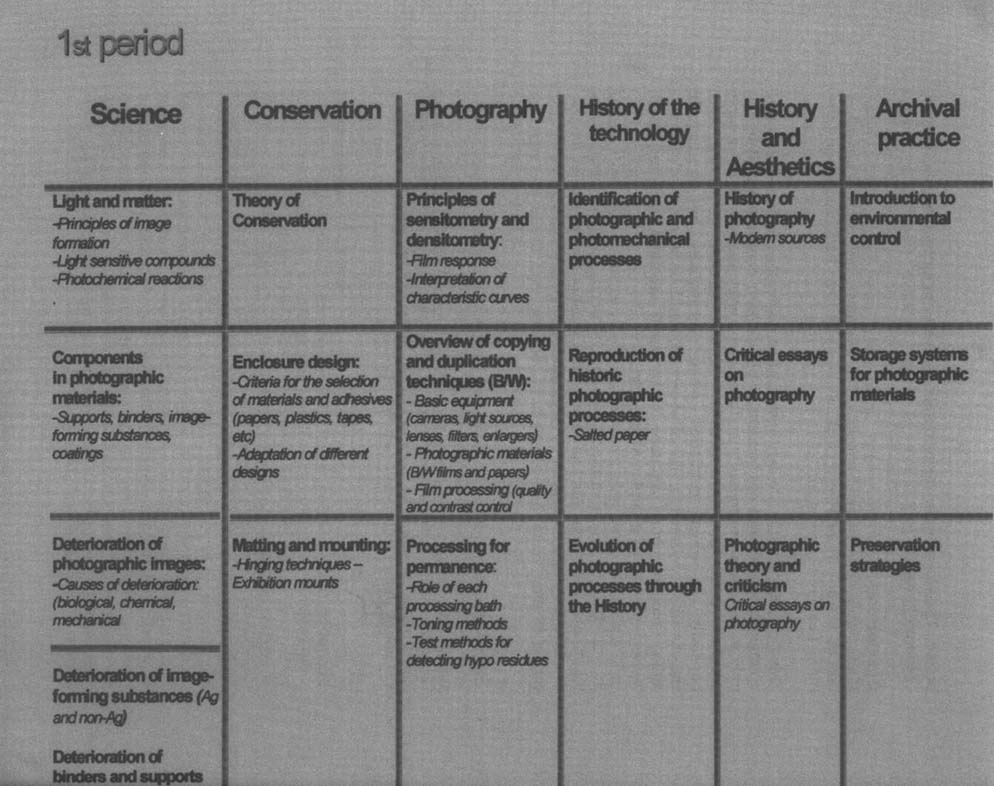
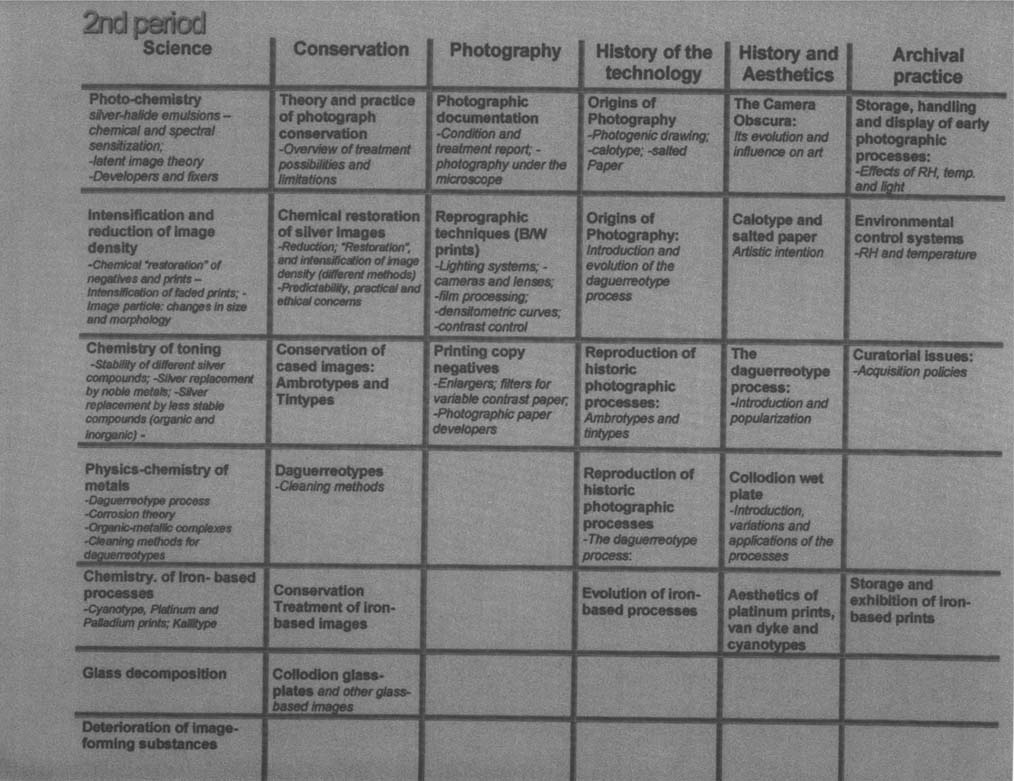
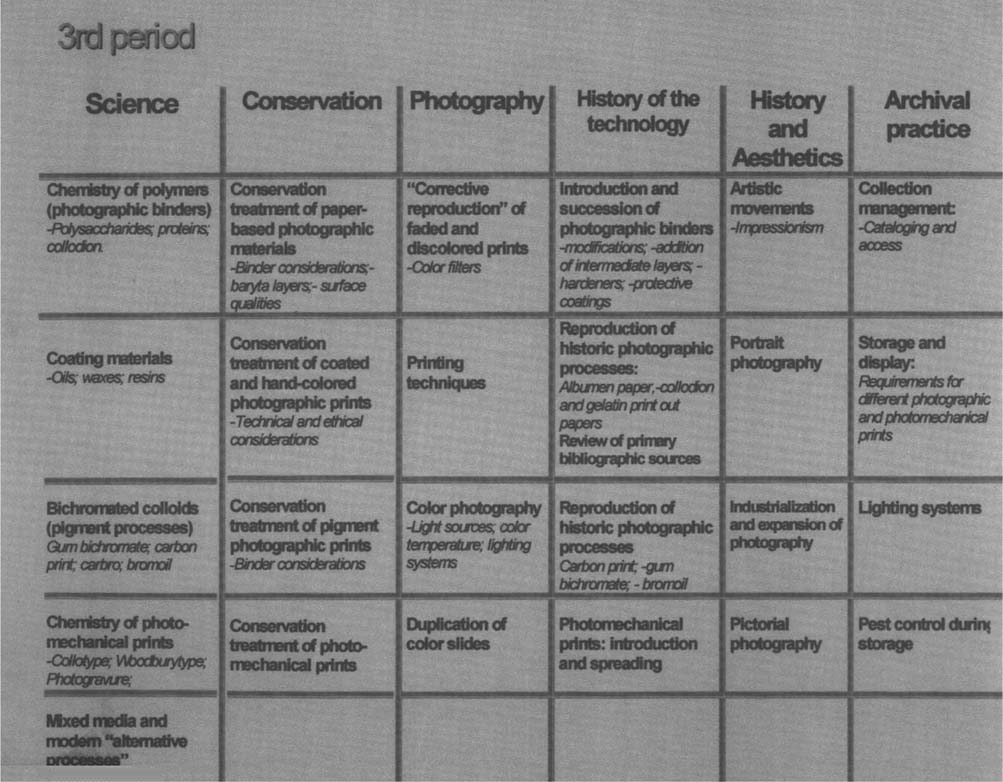
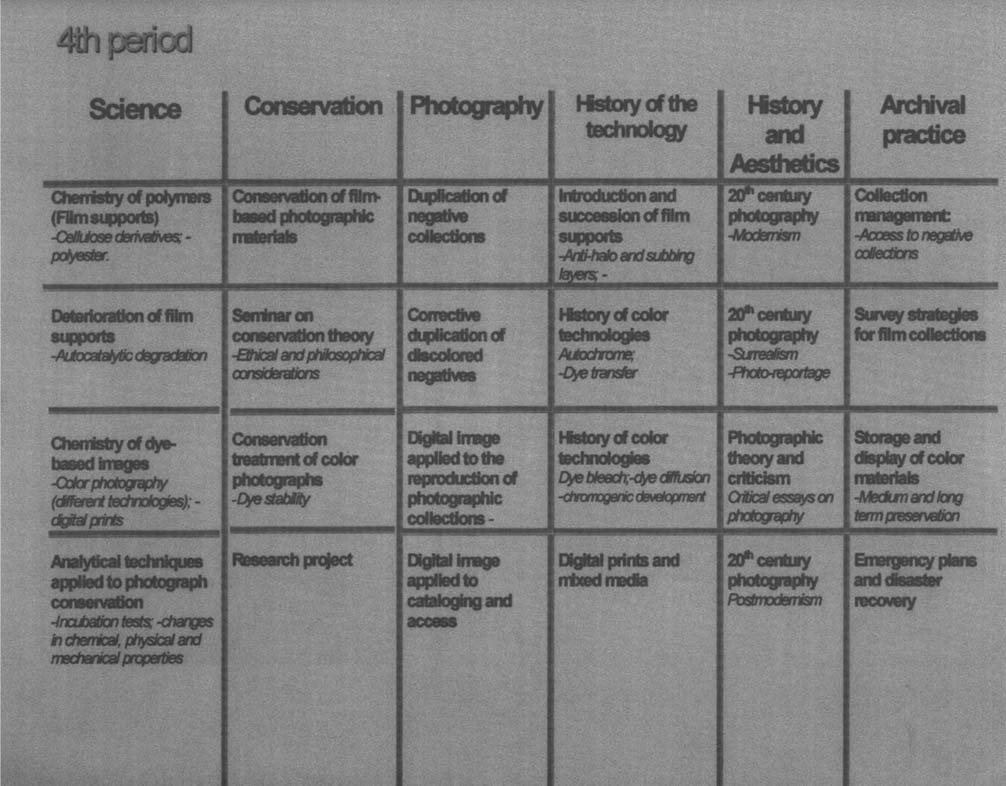
This project was possible thanks to the guidance, advice and educational opportunities provided by Deborah Hess Norris, Nora Kennedy, Douglas Nishimura, James Reilly and Grant Romer.
1 Survey Towards the Ideal Training for a Conservator of Photographs, and paper entitled The Coming Age of Photograph Conservation (ICOM Committee for Conservation, 1996) by Nora Kennedy; besides the opening of the Mellon Advanced Residency Program in Photograph Conservation, George Eastman House, are examples of current efforts to improve the education and promote further specialization of graduate conservators.
2 Opinions by professors Nora Kennedy, Deborah Hess Norris, Grant Romer and Douglas Nishimura, were considered for the definition and inclusion of the six areas.
3 Hill Stoner, Joyce, “The Education and Training of Art Conservators: Teaching the Triptych of Practice, History and Science”, ICOM Committee for Conservation, 1996.
4 Both needs have already been recognized by American educators and will be addressed through the Mellon Advanced Residency Program